Beelink GTR7 mini-PC Review: A Complete AMD Phoenix Package at 65W
by Ganesh T S on August 24, 2023 8:00 AM ESTWorkstation Performance - SPECworkstation 3.1
SFF PCs traditionally do not lend themselves to workstation duties. However, a recent trend towards miniaturized workstations has been observed. While the Raptor Canyon NUC is primarily marketed towards gamers, its capabilities encouraged us to benchmark the system for both content creation workloads as well as professional applications. Towards this, we processed two SPEC benchmarks geared towards workstations - SPECworkstation 3.10 and SPECviewperf 2020 v3.
SPECworkstation 3.1
The SPECworkstation 3.1 benchmark measures workstation performance based on a number of professional applications. It includes more than 140 tests based on 30 different workloads that exercise the CPU, graphics, I/O and memory hierarchy. These workloads fall into different categories.
- Media and Entertainment (3D animation, rendering)
- Product Development (CAD/CAM/CAE)
- Life Sciences (medical, molecular)
- Financial Services
- Energy (oil and gas)
- General Operations
- GPU Compute
Individual scores are generated for each test and a composite score for each category is calculated based on a reference machine (HP Z240 tower workstation using an Intel E3-1240 v5 CPU, an AMD Radeon Pro WX3100 GPU, 16GB of DDR4-2133, and a SanDisk 512GB SSD). Official benchmark results generated automatically by the benchmark itself are linked in the table below for the systems being compared.
| SPECworkstation 3.1 Official Results (2K) | |
| Beelink GTR7 | Run Summary |
| ASRock DeskMeet B660 | Run Summary |
| GEEKOM AS 6 (ASUS PN53) | Run Summary |
| ASRock NUC BOX-1260P | Run Summary |
| ASRock NUC BOX-1360P-D5 (Performance) | Run Summary |
| ASRock 4X4 BOX-7735U (Performance) | Run Summary |
| ASRock 4X4 BOX-5800U (Performance) | Run Summary |
| Intel NUC13ANKi7 (Arena Canyon) | Run Summary |
Details of the tests in each category, as well as an overall comparison of the systems on a per-category basis are presented below.
Media and Entertainment
The Media and Entertainment category comprises of workloads from five distinct applications:
- The Blender workload measures system performance for content creation using the open-source Blender application. Tests include rendering of scenes of varying complexity using the OpenGL and ray-tracing renderers.
- The Handbrake workload uses the open-source Handbrake application to transcode a 4K H.264 file into a H.265 file at 4K and 2K resolutions using the CPU capabilities alone.
- The LuxRender workload benchmarks the LuxCore physically based renderer using LuxMark.
- The Maya workload uses the SPECviewperf 13 maya-05 viewset to replay traces generated using the Autodesk Maya 2017 application for 3D animation.
- The 3ds Max workload uses the SPECviewperf 13 3dsmax-06 viewset to replay traces generated by Autodesk's 3ds Max 2016 using the default Nitrous DX11 driver. The workload represents system usage for 3D modeling tasks.
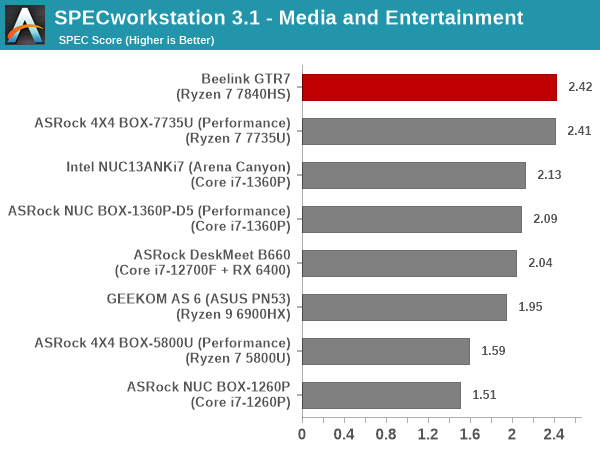
This category sees the different systems getting ordered on the basis of the configured sustained TDP. The GTR7 with its 65W TDP is at the top, followed closely behind by the 4X4 BOX-7735U with its 42W TDP, and the 40W RPL-P systems (including the Arena Canyon NUC) follow behind. The Rembrandt-R-based GEEKOM AS 6 with its 35W setting is in the middle of the pack, ahead of the previous generation systems.
Product Development
The Product Development category comprises of eight distinct workloads:
- The Rodinia (CFD) workload benchmarks a computational fluid dynamics (CFD) algorithm.
- The WPCcfd workload benchmarks another CFD algorithm involving combustion and turbulence modeling.
- The CalculiX workload uses the Calculix finite-element analysis program to model a jet engine turbine's internal temperature.
- The Catia workload uses the catia-05 viewset from SPECviewperf 13 to replay traces generated by Dassault Systemes' CATIA V6 R2012 3D CAD application.
- The Creo workload uses the creo-02 viewset from SPECviewperf 13 to replay traces generated by PTC's Creo, a 3D CAD application.
- The NX workload uses the snx-03 viewset from SPECviewperf 13 to replay traces generated by the Siemens PLM NX 8.0 CAD/CAM/CAE application.
- The Solidworks workload uses the sw-04 viewset from SPECviewperf 13 to replay traces generated by Dassault Systemes' SolidWorks 2013 SP1 CAD/CAE application.
- The Showcase workload uses the showcase-02 viewset from SPECviewperf 13 to replay traces from Autodesk???s Showcase 2013 3D visualization and presentation application
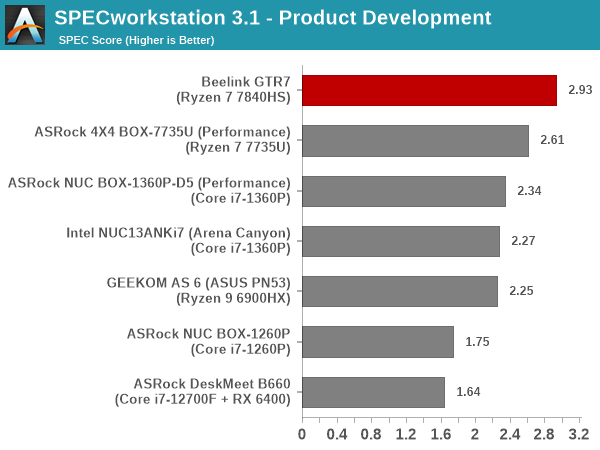
The trend observed in the Media and Entertainment category repeats here, with the GTR7 faring better than the 4X4 BOX-7735U. The performance advantage is also more noticeable and representative of the 65W - 42W gap in the TDPs.
Life Sciences
The Life Sciences category comprises of four distinct test sets:
- The LAMMPS set comprises of five tests simulating different molecular properties using the LAMMPS molecular dynamics simulator.
- The NAMD set comprises of three tests simulating different molecular interactions.
- The Rodinia (Life Sciences) set comprises of four tests - the Heartwall medical imaging algorithm, the Lavamd algorithm for calculation of particle potential and relocation in a 3D space due to mutual forces, the Hotspot algorithm to estimate processor temperature with thermal simulations, and the SRAD anisotropic diffusion algorithm for denoising.
- The Medical workload uses the medical-02 viewset from SPECviewperf 13 to determine system performance for the Tuvok rendering core in the ImageVis3D volume visualization program.
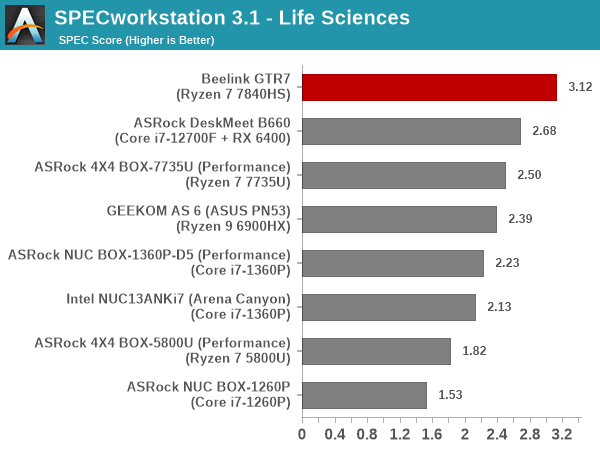
The addition of a GPU-centric component in the workload allows the Rembrandt-R-based GEEKOM AS 6 to leapfrog the RPL-P-based systems, but the 65W configuration of the GTR7 continues to enjoy a healthy lead.
Financial Services
The Financial Services workload set benchmarks the system for three popular algorithms used in the financial services industry - the Monte Carlo probability simulation for risk assessment and forecast modeling, the Black-Scholes pricing model, and the Binomial Options pricing model.
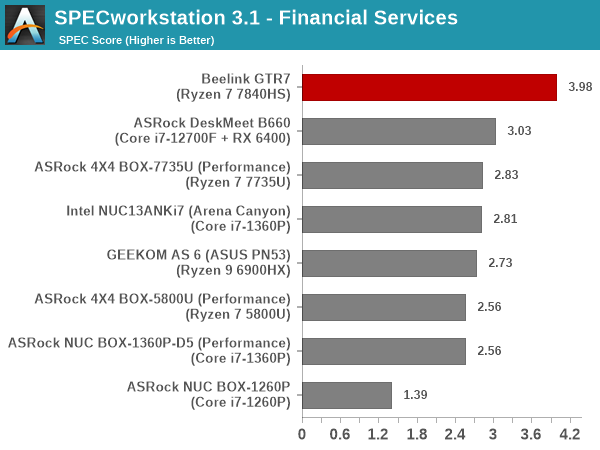
The GTR7 continues to outperform the rest of the systems in this workload set also. The comparison against the DeskMeet B660 is particularly striking. Devoting 65W to eight high-performance and four efficiency cores is not a particularly good solution compared to devoting 65W completely to eight high-performance cores - particularly when the task at hand is a single workload requiring extensive CPU power.
Energy
The Energy category comprises of workloads simulating various algorithms used in the oil and gas industry:
- The FFTW workload computes discrete Fourier transforms of large matrices.
- The Convolution workload computes the convolution of a random 100x100 filter on a 400 megapixel image.
- The SRMP workload processes the Surface-Related Multiples Prediction algorithm used in seismic data processing.
- The Kirchhoff Migration workload processes an algorithm to calculate the back propogation of a seismic wavefield.
- The Poisson workload takes advantage of the OpenMP multi-processing framework to solve the Poisson's equation.
- The Energy workload uses the energy-02 viewset from SPECviewperf 13 to determine system performance for the open-source OPendTec seismic visualization application.
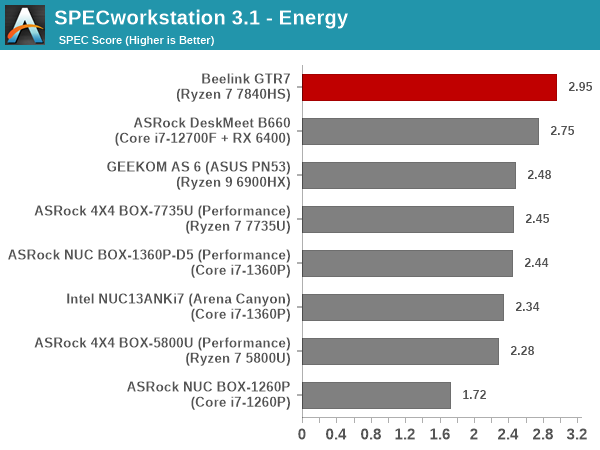
This workload also includes a GPU-centric component. The mixture of CPU-heavy and GPU-heavy operations is such that the GTR7 even outperforms the DeskMeet B660 with a low-end discrete GPU. Other systems are ordered in terms of TDP, with differences being in the realm of run-to-run variations).
General Operations
In the General Options category, the focus is on workloads from widely used applications in the workstation market:
- The 7zip workload represents compression and decompression operations using the open-source 7zip file archiver program.
- The Python workload benchmarks math operations using the numpy and scipy libraries along with other Python features.
- The Octave workload performs math operations using the Octave programming language used in scientific computing.
- The Storage workload evaluates the performance of the underlying storage device using transaction traces from multiple workstation applications.
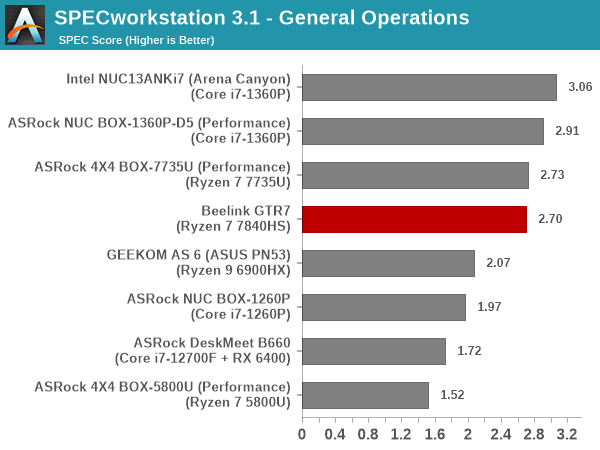
The components in this workload benefit from single-threaded performance as well as high-performance storage subsystems. The SSD used in the Arena Canyon NUC, NUC BOX-1360P/D5, and 4X4 BOX-7735U use SSDs with DRAM for the FTL. While the Crucial P3 Plus in the GTR7 doesn't have DRAM, it is compensated by much higher CPU performance. As a result, there is a significant gulf in the scores of the other systems and the above systems, with the GTR7 belonging to the leading pack - albeit, at its bottom.
GPU Compute
In the GPU Compute category, the focus is on workloads taking advantage of the GPU compute capabilities using either OpenCL or CUDA, as applicable:
- The LuxRender benchmark is the same as the one seen in the media and entertainment category.
- The Caffe benchmark measures the performance of the Caffe deep-learning framework.
- The Folding@Home benchmark measures the performance of the system for distributed computing workloads focused on tasks such as protein folding and drug design.
We only process the OpenCL variants of the benchmark, as the CUDA version doesn't process correctly with default driver installs.
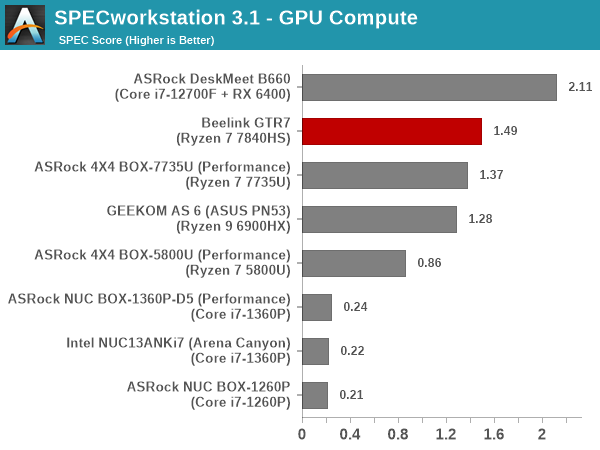
The GTR7 has the highest power budget and the latest integrated GPU microarchitecture. It is no surprise, therefore, that the system comes out on top among all the UCFF / SFF systems with iGPUs in the GPU Compute workloads.










56 Comments
View All Comments
ganeshts - Friday, August 25, 2023 - link
The fan shown in the photo is for the RAM and the SSD (please take a look at the picture in the thermal characteristics section for more context on where that fan goes in the overall system).The fan behind the heat spreaders connected to the vapor chamber is not pictured in the article, but available in the cross-sectional view on Beelink's product page:
https://img.bee-link.com/media/upload/5/o2/5o29ppo...
It is a typical notebook fan, and combined with the vapor chamber, it is effective enough to handle the 65W cTDP setting.
abufrejoval - Friday, August 25, 2023 - link
"pro" vs. "non-pro" in APU or Ryzen G parlance used to indicate support for ECC RAM, which for some reason was *not* included for the APUs vs the "normal" Ryzens.So my question here is: does the Pro variant (with a Ryzen 7 7845) support ECC RAM?
Because that's pretty much the only remaining item on my wish lilst for this class of machine (well, I'd rather have them as Mini-ITX, but that doesn't seem to happen).
abufrejoval - Monday, August 28, 2023 - link
Just in case somebody else wonders: Pro vs. non-Pro evidently is no longer a differentitator for ECC support on the Phoenix series APUs. It's all in the "socket" or rather package; FP7 and FP8 do not support ECC while FP7r2 *can*, if the platform does, independent of the particular chips (Ryzen 3 vs 9) or the "Pro": each chip is available in each "socket" or form factor...And to muddy the waters even further, you can't tell the "socket" from the branding/model, I supposed there is a part number that will tell you but for a device like this, you'd mostly have to hope that the vendor will tell you.... fat chance, I'd say from past experience.
And looking at the *5 parts, I noticed that for Phoenix this is used to indicated the desktop die derived high-TDP mobile parts using the FL1 "socket": while the desktop chips generally support ECC, these mobile workstation parts absolutely do not, most likely because the FL1 "socket" otherwise would have required a couple of extra traces...
Sometimes I'd like to have a word with AMD's cost cutters, beause they keep cutting into vital flesh and kill entire market niches with their excess.
abufrejoval - Monday, August 28, 2023 - link
Digging further (sorry), the availability of DDR5 sockets seems to indicate FP7r2: FP7 and FP8 seem to be exclusively (soldered) LPDDR5.There are SO-DIMM 32GB, DDR5-4800, CL40-39-39, ECC, on-die ECC modules available from Kingston which are listed as dual-rank x8, while AMD lists "4x2R" support...
Ganesh if you happen to have some ECC DDR5 SO-DIMMs available I'd be really thankful for a test!
And the Dragon Range (desktop derived) FL1 "socket" parts definitely do not support LPDDR5,only (SO-)DIMMs but still no ECC....
jepo - Friday, August 25, 2023 - link
I bought one of these with the 7940HS via Aliexpress (679 gbp) in July after the review in ServeTheHome. It arrived in 2 weeks, same spec as this review except the 7940HS and mine is grey. I added an extra 2Tb Samsung 990 Pro SSD. To my surprise on first boot it has Windows 11 Pro installed. I gave it a CPU bound process to do that I expected to take 2 weeks given that is how long it would take on my 4 year old 3900X 12 core desktop. It completed in 10 days. During that time it was 100% CPU all cores. Yes the fan is quite noisy, but there was no throttling. In my opinion it's a great little box, and I've changed to use this as my main dev machne.shiromar - Monday, August 28, 2023 - link
I am consider something small and powerful for gen 7 game emulation. can this beelink handle the gen7 stuff?Also i would really like to install steamOS via holoiso. Does anyone know if this GPU plays nice with holo?
thanks